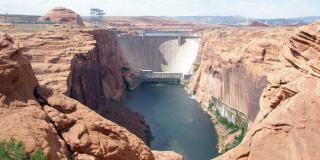Feds tighten Colorado River flow at Glen Canyon Dam as ever-shrinking Lake Powell nears critical level

As Lake Powell’s water level continues to decline, federal water managers will implement another round of emergency measures to keep the Utah largest’s reservoir from reaching a point where Glen Canyon Dam can no longer generate electricity.
The U.S. Bureau of Reclamation announced Friday that, over the next four months, it plans to hold back 350,000 acre-feet of water that would normally flow through Grand Canyon into Lake Mead, which is also struggling with a receding shoreline in the face of a stubborn drought.
Failure to act would result in Lake Powell reaching a critical elevation of 3,525 feet above sea level as early as next month, according to Wayne Pullan, the bureau’s Upper Colorado Basin regional director.
“Under the Drought Response Operations Agreement [between the seven basin states], making these monthly operational adjustments at Glen Canyon Dam is essential to protect Lake Powell from dropping to critically low elevation levels in the weeks and months ahead,” Pullan said. “Although the basin had substantial snowstorms in December, we don’t know what lies ahead and must do all we can now to protect Lake Powell’s elevation.”
On Friday, the lake stood at 3,536 feet, only 11 feet above the threshold elevation and 164 feet below full pool, according to the Lake Powell’s online database. Glen Canyon Dam’s hydropower turbines cannot be safely operated at elevations below 3,490 feet — the threshold elevation was set to with a 35-foot buffer.
After the spring runoff, the Bureau of Reclamation will increase releases from the dam — which marks the dividing point between the Colorado’s upper and lower basins — to make up for the water held back this winter, so the net amount of water passing through the dam in 2022 won’t change.
The latest moves comes after the bureau released 181,000 acre-feet from Flaming Gorge and two other upstream reservoirs last fall in the hopes of forestalling a crisis on Lake Powell. It appears that “emergency” move only delayed the crisis by a few months.
While the water year has gotten off to a promising start, November proved to be the basin’s second-driest on recording, resulting in a loss of 1.5 million acre-feet of inflow to Lake Powell compared to earlier projections, according to a the bureau’s announcement. Following December’s big storms, the Colorado’s upper basin snowpacks are presently 136% of average. A lot of that runoff would be captured in upstream reservoirs, which are also badly depleted, before reaching Lake Powell.
If future projections indicate the new release adjustments won’t be sufficient to safeguard Lake Powell’s elevation, the bureau will consider even more water releases from Flaming Gorge, Blue Mesa and Navajo reservoirs. Meanwhile, the bureau and upper basin states continue to work on a new drought-response operations plan, which is expected to be completed in April.
“The plans adopted in previous years, including the 2007 Interim Guidelines and the Drought Contingency and Binational Water Scarcity Contingency plans, along with voluntary actions, have helped sustain the Colorado River System through the current 22-year-long drought,” said Reclamation’s Lower Colorado Basin Regional Director Jaci Gould. “We’ll continue to work with our basin partners in the future in the same collaborative spirit we have demonstrated in the past.”

